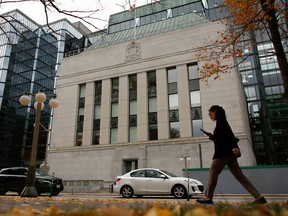Recent global economic developments were top of mind in governing council’s decision to hold rate at 5%
Article content
The Bank of Canada held its key overnight rate at five per cent on Dec. 6, a move that was widely expected by economists and markets. On Dec. 20, the central bank released a summary of the deliberations that led to that monetary policy decision. Here are five things the governing council said affected the decision:
The global economy is cooling faster than the U.S.
Article content
Advertisement 2
Article content
The bank said recent global economic developments were top of mind in its decision to hold rates earlier this month. It said the U.S. economy’s stronger-than-expected performance in October had been offset by weakness in the rest of the world, and that inflation was easing in most major economies. “As global growth slowed in recent months, inflation eased further,” the central bank said. Lower energy prices and declines in food and core goods inflation contributed to a drop in overall year-over-year inflation in the U.S. and the euro area. That altered market expectations for central bank policy, making them less inclined to raise rates this month.
The Canadian economy is no longer experiencing excess demand
Data for the third quarter showed economic growth had contracted at a rate of 1.1 per cent, after expanding at a rate of 1.4 per cent in the second quarter, the bank said. Higher interest rates continued to restrain consumer spending and consumption fell flat over the second and third quarters. Meanwhile, final domestic demand grew by 1.3 per cent in each of the last two quarters as a result of positive growth in government spending and residential construction. The increase in new home construction largely helped housing activity to rise by 8.3 per cent in the third quarter. The bank said that while this spending on new construction was encouraging to see, it would need to be a significant and sustained to resolve the long-standing structural shortage in supply. “Initial indicators for the fourth quarter suggested economic growth would remain weak as higher interest rates continued to hold back spending,” it said. Members of the governing council concluded the economy was no longer in excess demand. They said a range of indicators suggest the economy was approaching balance in the third quarter, while growth is expected to be weak in the fourth quarter.
Article content
Advertisement 3
Article content
Labour markets are easing, but wage growth remains strong
Data from the most recent labour force survey pointed to continued easing in the labour market, the Bank of Canada said, with job vacancies falling close to pre-pandemic levels. Job growth also continued to rise more slowly than the pace implied by population growth, and the unemployment rate picked up slightly in November to 5.8 per cent. “However, members noted that wage growth remained elevated, within a four to five per cent range,” it said. Public sector wage growth had risen since the start of the year, while that in the private sector had eased slightly.
Inflation is still too high
Consumer price index (CPI) inflation eased to 3.1 per cent in October from 3.8 per cent in September. “The evidence was clear that higher interest rates had reduced price pressures on a broadening range of goods and services,” the central bank said, added that the share of CPI components growing above three per cent and five per cent year-over-year continued to tick down in October. Many durable goods saw price declines in October, while services price inflation excluding shelter was lower than earlier in the year. Shelter price inflation, led by higher mortgage interest costs, accelerated by 6.1 per cent in October and contributed 1.8 percentage points to the total CPI reading of 3.1 per cent. The bank, however, said that the strong growth in rent and other components linked to house prices, such as insurance, taxes and maintenance, remains unusual. “Higher interest rates were restraining demand for housing, but the structural shortage of supply was supporting elevated house prices,” it said. Overall, core measures of inflation had remained in the 3.5 per cent to four per cent range but had edged down to the lower end of that range in October. On a three-month annualized basis, core inflation dropped to about three per cent.
Advertisement 4
Article content
Related Stories
-

The dirty little secret about inflation that rarely gets attention
-

Inflation sticks at 3.1%, staying above Bank of Canada target
-

What economists say about the latest inflation numbers
Previous rate hikes are still feeding through the economy
The Bank said its members agreed that past increases in the policy interest rate were continuing to feed through the economy, slowing spending and relieving price pressures. Their outlook for the economy was broadly in line with the October projection, with data indicating continued slow growth in the fourth quarter. “With the economy no longer in excess demand, members agreed they would be watching for signs that the slowdown in the economy was translating into further and sustained easing in inflation,” the bank said. While recent data indicated that monetary policy was working as expected to slow economic activity and ease inflationary pressures, the bank said inflation nevertheless remained too high, and that it needed to see a further and sustained decline in core inflation. Its members agreed that it is increasingly likely that monetary policy has been sufficiently restrictive to achieve the inflation target, but risks remained and further rate hikes could not be ruled out.
• Email: dpaglinawan@postmedia.com
Bookmark our website and support our journalism: Don’t miss the business news you need to know — add financialpost.com to your bookmarks and sign up for our newsletters here.
Article content
What Bank of Canada was thinking when it held rates on Dec. 6, 2023
2023-12-20 22:35:01







